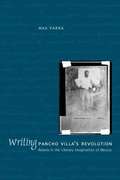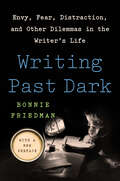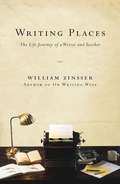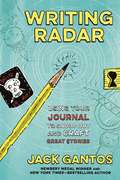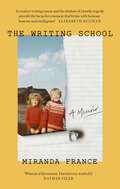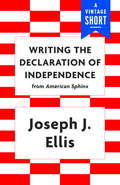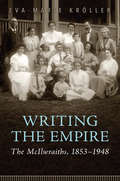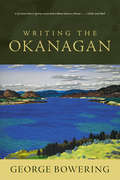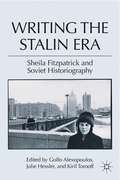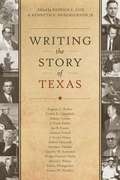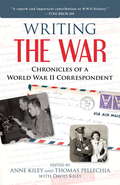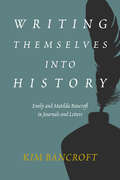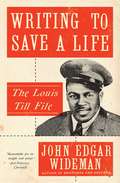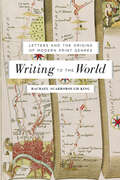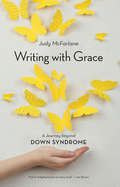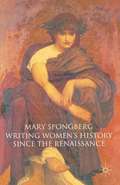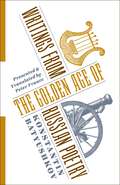- Table View
- List View
Writing Pancho Villa's Revolution: Rebels in the Literary Imagination of Mexico
by Parra MaxThe 1910 Mexican Revolution saw Francisco "Pancho" Villa grow from social bandit to famed revolutionary leader. <P>Although his rise to national prominence was short-lived, he and his followers (the villistas) inspired deep feelings of pride and power amongst the rural poor. After the Revolution (and Villa's ultimate defeat and death), the new ruling elite, resentful of his enormous popularity, marginalized and discounted him and his followers as uncivilized savages. Hence, it was in the realm of culture rather than politics that his true legacy would be debated and shaped.<P>Mexican literature following the Revolution created an enduring image of Villa and his followers. Writing Pancho Villa's Revolution focuses on the novels, chronicles, and testimonials written from 1925 to 1940 that narrated Villa's grassroots insurgency and celebrated—or condemned—his charismatic leadership. By focusing on works by urban writers Mariano Azuela (Los de abajo) and Martín Luis Guzmán (El águila y la serpiente), as well as works closer to the violent tradition of northern Mexican frontier life by Nellie Campobello (Cartucho), Celia Herrera (Villa ante la historia), and Rafael F. Muñoz (¡Vámonos con Pancho Villa!), this book examines the alternative views of the revolution and of the villistas. Max Parra studies how these works articulate different and at times competing views about class and the cultural "otherness" of the rebellious masses. This unique revisionist study of the villista novel also offers a deeper look into the process of how a nation's collective identity is formed.
Writing Past Dark: Envy, Fear, Distraction and Other Dilemmas in the Writer's Life
by Bonnie FriedmanWriting Past Dark charts the emotional side of the writer's life. It is a writing companion to reach for when you feel lost and want to regain access to the memories, images, and the ideas inside you that are the fuel of strong writing. Combining personal narrative and other writers' experiences, Friedman explores a whole array of emotions and dilemmas writers face—envy, distraction, guilt, and writer's block—and shares the clues that can set you free. Supportive, intimate, and reflective, Writing Past Dark is a comfort and resource for all writers.
Writing Places: The Life Journey of a Writer and Teacher
by William ZinsserWilliam Zinsser's journey to all the places where he has done his writing and his teaching begins in 1946, with his first job at the New York Herald Tribune, a community of legendary journalists and oddballs, in its postwar years of glory. Next came 11 years of freelance writing for magazines, mainly covering the turbulent 1960s for Life, a period that found the writer and his typewriter perched in many unusual locations. After that he spent a decade at Yale University, where his office as master of Branford College was beneath a 44-bell carillon. At Yale he originated his famous "nonfiction workshop," which would launch the careers of many exceptional writers and editors. That course led to his classic book, On Writing Well, which he wrote during the summer of 1974 in a crude shed in Connecticut. In this new memoir Zinsser recalls the processes that went into creating that original edition and revising it over the next 30 years to keep pace with changes in the language and culture of America. His journey brings him back to New York City and to writing articles and books in quirky rented offices, one of which had a fire pole. Written with humor and with gratitude for a lifetime of change and self-discovery, relishing a rich cast of characters that ranges from Yale's president Kingman Brewster to the actor Peter Sellers and the gonzo journalist Hunter S. Thompson, Writing Places never loses its anchor in the craft of writing--how writing is taught, learned and finally brought to a high level of enjoyment.
Writing Places
by William ZinsserWilliam Zinsser's journey to all the places where he has done his writing and his teaching begins in 1946, with his first job at the New York Herald Tribune, a community of legendary journalists and oddballs, in its postwar years of glory. Next came 11 years of freelance writing for magazines, mainly covering the turbulent 1960s for Life, a period that found the writer and his typewriter perched in many unusual locations.After that he spent a decade at Yale University, where his office as master of Branford College was beneath a 44-bell carillon. At Yale he originated his famous "nonfiction workshop," which would launch the careers of many exceptional writers and editors. That course led to his classic book, On Writing Well, which he wrote during the summer of 1974 in a crude shed in Connecticut. In this new memoir Zinsser recalls the processes that went into creating that original edition and revising it over the next 30 years to keep pace with changes in the language and culture of America. His journey brings him back to New York City and to writing articles and books in quirky rented offices, one of which had a fire pole.Written with humor and with gratitude for a lifetime of change and self-discovery, relishing a rich cast of characters that ranges from Yale's president Kingman Brewster to the actor Peter Sellers and the gonzo journalist Hunter S. Thompson, Writing Places never loses its anchor in the craft of writing--how writing is taught, learned and finally brought to a high level of enjoyment.
Writing Radar: Using Your Journal to Snoop Out and Craft Great Stories
by Jack GantosThe Newbery Award–winning author of Dead End in Norvelt shares advice for how to be the best brilliant writer in this funny and practical creative writing guide perfect for all kids who dream of seeing their name on the spine of a book.With the signature wit and humor that have garnered him legions of fans, Jack Gantos instructs young writers on using their "writing radar" to unearth story ideas from their everyday lives. Incorporating his own misadventures as a developing writer, Gantos inspires readers to build confidence and establish good writing habits as they create, revise, and perfect their stories. Pop-out text boxes highlight key tips, alongside Gantos's own illustrations, sample stories, and snippets from his childhood journals. More than just a how-to guide, Writing Radar is a celebration of the power of storytelling and an ode to the characters who—many unwittingly—inspired Gantos's own writing career.
The Writing School
by Miranda France'Both extremely funny and deeply sad, The Writing School examines how and why we tell our own stories. It's beautifully written and structured, compelling, wise and fabulously readable' Lissa Evans'The Writing School is an extraordinary book. It is funny, exhilarating, heart-breaking and passionate. Its delicate pulsing themes are held like a bird in the writer's confident, gentle hand' Katharine Norbury'Life, with its unexpected troughs and highs, the disciplines of teaching a creative writing course and the shadow of a family tragedy provide the focus for a memoir that brims with humour, honesty and intelligence. The Writing School taught me a lot' Elizabeth BuchanA creative writing course is a chance for reinvention. When author Miranda France sets off to teach at a residential writing school in a remote valley, she expects to meet a group of aspiring writers with the usual mix of hope and unrealised ambitions, talents and motivation.Tensions are bound to emerge over the course of the week they spend together: personalities will clash, egos will need to be tamed or gently encouraged. What France doesn't expect, as she takes her tutees through a series of exercises designed to help them explore different aspects of their writing, is that a ghost from her own life will join them.As the daily drama of the writing school unfurls, so memories resurface concerning a death that profoundly shaped the author's world when she was a teenager. Soon France's memories interweave with her present task of thinking about writing and storytelling, and she too becomes a student: asking, what is to be done with our memories of those we have lost? What is behind the urge to put lives into words? And is it ever right to tell another person's story?A delightful and unusual blend of storytelling and memoir, packed full of literary anecdote and insight from the author's own experience as well as that of other writers and poets, The Writing School is a moving and often very funny book about why people write, as well as being a uniquely generous masterclass on the art of writing itself.
Writing the Declaration of Independence (A Vintage Short)
by Joseph J. EllisA colorful, enlightening account of how Thomas Jefferson wrote the Declaration of Independence, and the road to July 4: a selection from Joseph J. Ellis's American Sphinx, winner of the National Book Award. How did the newest and youngest member of Virginia's delegation to the Constitutional Congress come to write the founding document of the American project? In "Writing the Declaration of Independence," Pulitzer Prize-winning historian Joseph J. Ellis outlines the life of the document and the road to its adoption on July 4. From Jefferson's arrival in Philadelphia in 1775 in an ornate carriage along with four horses and three slaves, to a fascinating guided tour of the drafts and discussions (including the importance of a good speaking voice, the theatricality of Patrick Henry, and Jefferson's tortured, ultimately discarded section blaming the king for American slavery), this is the true history of Independence Day.
Writing the Empire: The McIlwraiths, 1853–1948
by Eva-Marie KröllerWriting the Empire is a collective biography of the McIlwraiths, a family of politicians, entrepreneurs, businesspeople, scientists, and scholars. Known for their contributions to literature, politics, and anthropology, the McIlwraiths originated in Ayrshire, Scotland, and spread across the British Empire, specifically North America and Australia, from the mid-nineteenth century onwards. Focusing on imperial networking, Writing the Empire reflects on three generations of the McIlwraiths’ life writing, including correspondence, diaries, memoirs, and estate papers, along with published works by members of the family. By moving from generation to generation, but also from one stage of a person’s life to the next, the author investigates how various McIlwraiths, both men and women, articulated their identity as subjects of the British Empire over time. Eva-Marie Kröller identifies parallel and competing forms of communication that involved major public figures beyond the family’s immediate circle, and explores the challenges issued by Indigenous people to imperial ideologies. Drawing from private papers and public archives, Writing the Empire is an illuminating biography that will appeal to readers interested in the links between life writing and imperial history.
Writing the Monarch in Jacobean England
by Jane RickardKing James VI and I's extensive publications and the responses they met played a key role in the literary culture of Jacobean England. This book is the first sustained study of how James's subjects commented upon, appropriated and reworked these royal writings. Jane Rickard highlights the vitality of such responses across genres - including poetry, court masque, sermon, polemic and drama - and in the different media of performance, manuscript and print. The book focuses in particular on Jonson, Donne and Shakespeare, arguing that these major authors responded in illuminatingly contrasting ways to James's claims as an author-king, made especially creative uses of the opportunities that his publications afforded and helped to inspire some of what the King in turn wrote. Their literary responses reveal that royal writing enabled a significant reimagining of the relationship between ruler and ruled. This volume will interest researchers and advanced students of Renaissance literature and history.
Writing the Okanagan
by George BoweringGeorge Bowering was born in Penticton, where his great-grandfather Willis Brinson lived, and Bowering has never been all that far from the Okanagan Valley in his heart and imagination. Early in the twenty-first century, he was made a permanent citizen of Oliver. Bowering has family up and down the Valley, and he goes there as often as he can. He has been asked during his many visits to Okanagan bookstores over the years to publish a collection of his writing about the Valley.Writing the Okanagan draws on forty books Bowering has published since 1960 - poetry, fiction, history, and some forms he may have invented. Selections from Delsing (1961) and Sticks & Stones (1962) are here, as is "Driving to Kelowna" from The Silver Wire (1966). Other Okanagan towns, among them Rock Creek, Peachland, Vernon, Kamloops, Princeton, and Osoyoos, inspire selections from work published through the 1970s and on to 2013. Fairview, the old mining site near Oliver, is the focus of an excerpt from Caprice (1987, 2010), one volume in Bowering's trilogy of historical novels. "Desert Elm" takes as its two main subjects the Okanagan Valley and his father, who, as Bowering did, grew up there. With the addition of some previously unpublished works, the reader will find the wonder of the Okanagan here, in both prose and poetry.
Writing the Stalin Era
by Golfo Alexopoulos Julie Hessler Kiril TomoffCovering topics such as the Soviet monopoly over information and communication, violence in the gulags, and gender relations after World War II, this festschrift volume highlights the work and legacy of Sheila Fitzpatrick offers a cross-section of some of the best work being done on a critical period of Russia and the Soviet Union.
Writing the Story of Texas
by Patrick L. Cox Kenneth E. Hendrickson Jr.The history of the Lone Star state is a narrative dominated by larger-than-life personalities and often-contentious legends, presenting interesting challenges for historians. Perhaps for this reason, Texas has produced a cadre of revered historians who have had a significant impact on the preservation (some would argue creation) of our state's past. An anthology of biographical essays, Writing the Story of Texas pays tribute to the scholars who shaped our understanding of Texas's past and, ultimately, the Texan identity. Edited by esteemed historians Patrick Cox and Kenneth Hendrickson, this collection includes insightful, cross-generational examinations of pivotal individuals who interpreted our history. On these pages, the contributors chart the progression from Eugene C. Barker's groundbreaking research to his public confrontations with Texas political leaders and his fellow historians. They look at Walter Prescott Webb's fundamental, innovative vision as a promoter of the past and Ruthe Winegarten's efforts to shine the spotlight on minorities and women who made history across the state. Other essayists explore Llerena Friend delving into an ambitious study of Sam Houston, Charles Ramsdell courageously addressing delicate issues such as racism and launching his controversial examination of Reconstruction in Texas, Robert Cotner-an Ohio-born product of the Ivy League-bringing a fresh perspective to the field, and Robert Maxwell engaged in early work in environmental history.
Writing the War
by Anne Kiley Thomas Pellechia David KileyAs expansive as it is personal, this chronicle of World War II is a firsthand account by a journalist and the woman he would marry of the dramatic events that engulfed the world in the middle of the twentieth century. The correspondence between Charles Kiley and Billee Gray also tells the poignant tale of two young people in love but forced apart by the circumstances of war. Edited by Charles and Billee's daughter, son, and son-in-law, this never-before-published compilation of letters is a striking example of the heroic, call-to-duty spirit that characterized "the greatest generation. " Charles was a soldier-journalist for the U. S. Army's Stars and Stripes newspaper and reported on the war from London, Normandy, Paris, Reims, Belgium, and Germany. As the sole reporter allowed direct access to Eisenhower's staff, he was the only reporter on the scene when the German high command was negotiating its unconditional surrender on May 7, 1945. Among his army newspaper friends and colleagues was Andy Rooney, later CBS correspondent and 60 Minutes commentator. Billee, like many young women of her time, witnessed the war years from the home front and filled vital civilian roles-defense-industry plant worker, Red Cross volunteer, war bonds salesgirl, and civil defense plane-spotter-and wrote about it all in her letters to Charles. Peppered with fascinating details about soldiers' and civilians' lives, and including Stars and Stripes articles and personal photographs of the era, Writing the War is both important history and a tribute to two remarkable people as well as their extraordinary generation.
Writing Themselves into History: Emily and Matilda Bancroft in Journals and Letters
by Kim BancroftA window into the world of nineteenth-century California, from two women who experienced it firsthand In the early years of California’s statehood, Emily Brist Ketchum Bancroft (1834–1869) and Matilda Coley Griffing Bancroft (1848–1910) had front-row seats to the unfolding of the Golden State’s history. The first and second wives of historian extraordinaire Hubert Howe Bancroft, these two women were deeply engaged members of society and perceptive chroniclers of their times, and they left behind extensive records of their lives and work. Writing Themselves into History offers a rich immersion in nineteenth-century California, detailing Emily’s and Matilda’s experiences with public life, motherhood, and business against the backdrop of San Francisco’s high society and the state’s growth amidst the tumult of the American Civil War. The book also highlights Matilda’s significant involvement in Hubert Howe’s trailblazing research on the history of the American West—including her work collecting oral histories from women members of the LDS Church—and her evocative descriptions of travels throughout the Pacific Northwest and beyond. Kim Bancroft’s commentary offers historical context and points up Emily’s and Matilda’s keen insights, and she pays special attention to the two women’s complex and nuanced portraits of gender, race, and class in the nineteenth-century West. This book is a valuable resource for American West and women’s studies scholars, and for anyone with an interest in California’s first decades as a state.
Writing to Save a Life: The Louis Till File (Canons #84)
by John Edgar WidemanAn award-winning writer traces the life of the father of iconic Civil Rights martyr Emmett Till--a man who was executed by the Army ten years before Emmett's murder. An evocative and personal exploration of individual and collective memory in America by one of the most formidable Black intellectuals of our time.In 1955, Emmett Till, aged fourteen, traveled from his home in Chicago to visit family in Mississippi. Several weeks later he returned, dead; allegedly he whistled at a white woman. His mother, Mamie, wanted the world to see what had been done to her son. She chose to leave his casket open. Images of her brutalized boy were published widely. While Emmett's story is known, there's a dark side note that's rarely mentioned. Ten years earlier, Emmett's father was executed by the Army for rape and murder. In Writing to Save a Life, John Edgar Wideman searches for Louis Till, a silent victim of American injustice. Wideman's personal interaction with the story began when he learned of Emmett's murder in 1955; Wideman was also fourteen years old. After reading decades later about Louis's execution, he couldn't escape the twin tragedies of father and son, and tells their stories together for the first time. Author of the award-winning Brothers and Keepers, Wideman brings extraordinary insight and a haunting intimacy to this devastating story. An amalgam of research, memoir, and imagination, Writing to Save a Life is completely original in its delivery--an engaging and enlightening conversation between generations, the living and the dead, fathers and sons. Wideman turns seventy-five this year, and he brings the force of his substantial intellect and experience to this beautiful, stirring book, his first nonfiction in fifteen years.
Writing to the World: Letters and the Origins of Modern Print Genres
by Rachael Scarborough KingLetters played a foundational role in facilitating the rise of print and popularizing new modes of writing in the long eighteenth century.In Writing to the World, Rachael Scarborough King examines the shift from manuscript to print media culture in the long eighteenth century. She introduces the concept of the "bridge genre," which enables such change by transferring existing textual conventions to emerging modes of composition and circulation. She draws on this concept to reveal how four crucial genres that emerged during this time—the newspaper, the periodical, the novel, and the biography—were united by their reliance on letters to accustom readers to these new forms of print media.King explains that as newspapers, scientific journals, book reviews, and other new genres began to circulate widely, much of their form and content was borrowed from letters, allowing for easier access to these unfamiliar modes of printing and reading texts. Arguing that bridge genres encouraged people to see themselves as connected by networks of communication—as members of what they called "the world" of writing—King combines techniques of genre theory with archival research and literary interpretation, analyzing canonical works such as Addison and Steele’s Spectator, Samuel Johnson’s Lives of the Poets, and Jane Austen’s Northanger Abbey alongside anonymous periodicals and the letters of middle-class housewives. This original and groundbreaking work in media and literary history offers a model for the process of genre formation. Ultimately, Writing to the World is a sophisticated look at the intersection of print and the public sphere.
Writing to the World: Letters and the Origins of Modern Print Genres
by Rachael Scarborough King“King’s pitch for the indebtedness of the genres we know well—the novel, the biography, the magazine piece—to letter writing is stylish and convincing.” —Christina Lupton, author of Reading and the Making of Time in the Eighteenth CenturyIn Writing to the World, Rachael Scarborough King examines the shift from manuscript to print media culture in the long eighteenth century. She introduces the concept of the “bridge genre,” which enables such change by transferring existing textual conventions to emerging modes of composition and circulation. She draws on this concept to reveal how four crucial genres that emerged during this time—the newspaper, the periodical, the novel, and the biography—were united by their reliance on letters to accustom readers to these new forms of print media.King explains that as newspapers, scientific journals, book reviews, and other new genres began to circulate widely, much of their form and content was borrowed from letters, allowing for easier access to these unfamiliar modes of printing and reading texts. Arguing that bridge genres encouraged people to see themselves as connected by networks of communication—as members of what they called “the world” of writing—King combines techniques of genre theory with archival research and literary interpretation, analyzing canonical works such as Addison and Steele’s Spectator, Samuel Johnson’s Lives of the Poets, and Jane Austen’s Northanger Abbey alongside anonymous periodicals and the letters of middle-class housewives.This original and groundbreaking work in media and literary history offers a model for the process of genre formation. Ultimately, Writing to the World is a sophisticated look at the intersection of print and the public sphere.“This erudite, sophisticated, beautifully written book is a major achievement.” —Thomas Keymer, author of Poetics of the Pillory
Writing with Grace
by Judy McfarlaneWhen Judy McFarlane is asked if she will help Grace, a woman with Down syndrome who dreams of becoming a famous writer, she realizes she holds deep, unacknowledged fears - that Grace will be a dull-eyed young woman who can't read, let alone write, or that she might become agitated, even lash out. But the idea that Grace wants to be a writer, a dream McFarlane gave up when she was young, captures McFarlane. She helps Grace write her book and travels with Grace to give a copy of the book to her grandfather. Writing with Grace is the inspiring and informative story of the journey Grace and Judy have taken together. It relates the often-dark history of Down syndrome and tells a universal story of moving from a deep fear of the "other" to seeing the world through the eyes of another person. With honest introspection and keen insight, Writing with Grace delves into what it takes to face one's own prejudice and what it means to live a full life and believe you are worthy.
Writing Women’s History since the Renaissance
by Mary SpongbergThe complaint of Catherine Morland in Jane Austen's Northanger Abbey, that history has 'hardly any women at all' is not an uncommon one. Yet there is evidence to suggest that women have engaged in historical writing since ancient times. This study traces the history of women's historical writing, reclaiming the lives of individual women historians, recovering women's historical writings from the past and focusing on how gender has shaped the genre of history. Mary Spongberg brings together for the first time an extensive survey of the progress of women's historical writing from the Renaissance to the present, demonstrating the continuities between women's historical writings in the past and the development of a distinctly woman-centred historiography. Writing Women's History since the Renaissance also examines the relationship between women's history and the development of feminist consciousness, suggesting that the study of history has alerted women to their unequal status and enabled them to use history to achieve women's rights. Whether feminist or anti-feminist, women who have had their historical writings published have served as role models for women seeking a voice in the public sphere and have been instrumental in encouraging the growth of a feminist discourse.
Writings from the Golden Age of Russian Poetry (Russian Library)
by Konstantin BatyushkovKonstantin Batyushkov was one of the great poets of the Golden Age of Russian literature in the early nineteenth century. His verses, famous for their musicality, earned him the admiration of Alexander Pushkin and generations of Russian poets to come. In Writings from the Golden Age of Russian Poetry, Peter France interweaves Batyushkov’s life and writings, presenting masterful new translations of his work with the compelling story of Batyushkov’s career as a soldier, diplomat, and poet and his tragic decline into mental illness at the age of thirty-four. Little known among non-Russian readers, Batyushkov left a varied body of writing, both in verse and in prose, as well as memorable letters to friends. France nests a substantial selection of his sprightly epistles on love, friendship, and social life, his often tragic elegies, and extracts from his essays and letters within episodes of his remarkable life—particularly appropriate for a poet whose motto was “write as you live, and live as you write.” Batyushkov’s writing reflects the transition from the urbane sociability of the Enlightenment to the rebellious sensibility of Pushkin and Lermontov; it spans the Napoleonic Wars and the rapid social and literary change from Catherine the Great to Nicholas I. Presenting Batyushkov’s poetry of feeling and wit alongside his troubled life, Writings from the Golden Age of Russian Poetry makes his verse accessible to English-speaking readers in a necessary exploration of this transitional moment for Russian literature.
